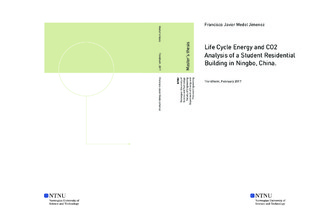| dc.description.abstract | Buildings with installed photovoltaic power systems tend to consume less energy and create less environmental damage. However, these photovoltaic power systems also can generate a significant amount of energy and environmental impacts during their manufacturing and installation processes. There are numerous life cycle assessment studies evaluating the amount of energy and carbon emissions that photovoltaic systems generate, but normally the system boundaries of these assessments are limited to the photovoltaic system excluding the building. The purpose of this thesis was to perform a comparative life cycle energy analysis of a student dormitory building in Ningbo, China with and without using a photovoltaic energy generator in its operational phase and to evaluate the efficiency of the photovoltaic system in terms of carbon emissions and energy performance. An energy contribution analysis and sensitivity analysis was also executed.
The research was conducted using a life cycle energy assessment method in which two separate assessments were performed: one for the student dormitory building and one for a solar panel. Construction, operation, and demolition life cycle phases of the building and the photovoltaic power system were included. Data was obtained from the original drawings of the case study building, and data from literature review was used for the solar panel. An energy and carbon emission contribution analysis was done before the installation of the photovoltaic system in the building. Later, a bigger energy model was created by combining the life cycle energy assessment of the building and the photovoltaic system. This model helped to complete a scenario and sensitive analysis so that the effects of modifying key input parameters and/or processes could be analyzed.
The results show that the total amount of energy consumed and carbon dioxide emissions generated during the life cycle of the dormitory was 5,907 kWh/m2 and 6 ton CO2-eq./m2 per 50 years. The HVAC system in the building emits more carbon dioxide and consumes more electricity than any other process. Total amount of energy consumed and carbon dioxide emissions generated during the life span of the photovoltaic power system was 1,277 kWh/m2 total usable area, and 2 ton CO2-eq./m2 usable area. The conversion of upgrading metallurgical silicon (UMG-Si) into solar grade silicon (SoG-Si) was the process consuming more energy and emitting more carbon dioxide. The installation of the photovoltaic system in the dormitory can reduce its direct energy by 15.63% and carbon emissions by 15.65% during its 50 years life span. In the case of the building s total life cycle energy consumption (direct and indirect energy), this reduction is 8.7% in terms of energy and 10.43% in the case of carbon emissions.
Result also revealed that using renewable energy as the energy supply of electricity generation for the manufacturing of solar panels and throughout the life cycle of the dormitory can help to enhance the benefits of installing photovoltaic systems. Using hydropower as energy supply 83.8% of carbon emissions reduction is obtained compare to the original 10.43%.
The installation of the photovoltaic power system helps to mitigate carbon dioxide and reduce energy consumption in the student dormitory. The system has more effects on the direct energy consumed by the building, although a precise and holistic amount of energy and carbon emission reduction is given by the building s total life cycle energy consumption (direct and indirect energy). The results presented here can assist to identify critical processes and to make changes that can help to improve the overall energy and carbon emission performance of the life cycle of the building and the photovoltaic system. The combined life cycle energy assessment model created in this thesis can be used as a tool to assess solar panel installation in buildings, as a tool to improve the production technology of photovoltaic systems and construction materials, as a reference for policy making, and as a benchmark for future research. | |

